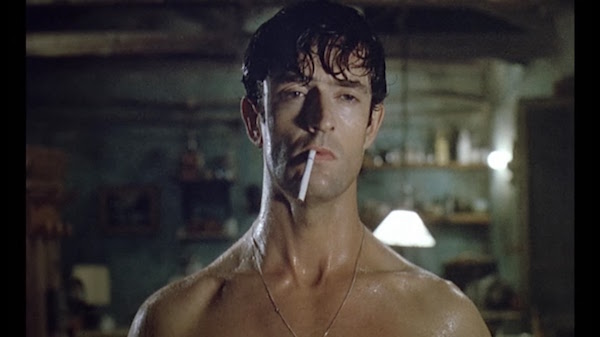A scene from Dash Shaw’s animated feature “My Entire High School Sinking Into the Sea.” | GKIDS
Cartoonist, writer, and director Dash Shaw’s “My Entire High School Sinking Into the Sea” is a complete delight, but it works almost entirely on the level of style. A takeoff on ‘80s teen movies, it dramatizes Dash’s own adolescence in animated form, elevating it to apocalyptic form. Yet all but a handful of the characters seem completely disposable. There’s enough gore that if the film weren’t animated, it would certainly be rated R.
Shaw manages to pull off a rare balance of tones: there’s something really nihilistic about his film, yet it feels cheerful and optimistic (and not because of the storyline about teenagers reconciling and surviving an earthquake together). He may be the Quentin Tarantino of American animation.
“My Entire High School Sinking Into the Sea” was hand-drawn over the course of several years, mostly by Shaw and his partner Jane Samborski in their kitchen. A few other animators were involved and rather than try to make the different artists’ work merge together seamlessly, the film revels in the clash of different styles. Shaw’s own drawing tends to be crude, even ugly. But even so, there are odd moments of beauty even at the bleakest moments – as a character is drowning, we see a lovely rendering of their lungs against a carefully drawn backdrop of cross-hatched lines.
Dash Shaw brings colorful verve to familiar tropes about adolescence
As Shaw’s film begins, Dash (Jason Schwartzman) and Assaf (Reggie Watts) are best friends about to start their sophomore year at Tides High School. They’re united by their love of journalism; together, they write for a newspaper edited by Verti (Maya Rudolph). However, no one reads the paper, despite stories written by Dash about a haunting at the high school, and its journalism grows ever more yellow until Dash becomes envious of Assaf and Verti’s increasing intimacy and turns on them.
None of this, however, matters once an earthquake strikes their school, which was irresponsibly built without proper protections. As water builds, Assaf, Verti, Dash, a small group of their classmates, and the lunch lady (Susan Sarandon) brave danger to climb the school’s levels — the structure refers explicitly to video games — and try and escape.
Shaw shows a knowledge of art history belied by the simplicity of many of his images. “My Entire High School Sinking Into the Sea” refers to Abstract Expressionism and offers up spinning colored grids and circles out of Op Art. The film’s sensibility also suggests a familiarity with psychedelic drugs, or at least the culture inspired by them. In an interview with Thomas Beard, Shaw points to Japanese animator Osamu Tezuka and his “Astro Boy” cartoons.
The cast of characters in “My Entire High School Sinking Into the Sea” is as multi-racial as you’d expect from a moderately woke 2016 film, with substantial parts given to Watts and Rudolph. But Shaw’s style questions the whole concept of how race should be represented. Even his white characters rarely have pink skin. The teenagers of this high school change skin color in the blink of an eye, as if they were dancing under a wild light show that only exists in Shaw’s imagination. White and black people alike turn shades that have no basis in reality, like bright red.
On one level, this is a purely abstract fantasy; on another, it raises a huge number of question marks about the idea of “realistic” depictions of whiteness and blackness. After all, some clueless Americans have claimed that characters in Japanese anime aren’t really meant to be Asian because they have blonde hair.
“My Entire High School Sinking Into the Sea” knows just how smart it is, name-checking Samuel R. Delany, Margaret Atwood, and Ursula K. Le Guin – for the skeptics in the audience – offering its own negative reviews at the end: “corny as hell.” Shaw may be inspired by ‘80s John Hughes films, but his tale of teenage angst and broken friendship really isn’t that interesting in and of itself, nor are his liftings from disaster movies.
What’s great about “My Entire High School Sinking Into the Sea” is the notion of setting these narrative banalities in a visual landscape that’s anything but banal, with constantly shifting style, color, and perspective. Mythologizing one’s adolescence has rarely been driven home with such imaginative force.
MY ENTIRE HIGH SCHOOL SINKING INTO THE SEA | Directed by Dash Shaw | GKids | Opens Apr. 14 | The Metrograph, 7 Ludlow St., btwn. Canal & Hester Sts. | metrograph.com



































